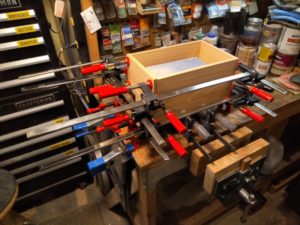Way back in 2012, I made a regular size karabitsu entirely by hand from cypress 1×12. I developed a set of ratios that enabled me to design a karabitsu based on the width of the wood. The length of the lid is twice the width of the wood, and so on down. Later, I made a small karabitsu out of cypress 1×10, using the same ratios. I decided to make a pair of even smaller karabitsu out of cypress 1×8, planing the wood down to half-inch thickness because I had purchased a planer. I cut all the pieces to length, and started cutting the joinery, but then life intervened. The pieces sat in a box next to my workbench for at least a year. Then we moved. Then the peces sat in a box on my workbench for four years. It was time to complete this project and get these dang things off my workbench.
I cut all the joinery by hand, but I quickly gave up on doing everything by hand. I used a band saw to cut the legs, a router to shape the legs, a sander to smooth out the boxes, and a drill to make holes for the pegs that secure everything. I did decide to use rice paste to assemble the boxes instead of using modern wood glue. I used more hand-mixed blonde shellac for the finish, and now finally these are done.
Here’s an image showing all four karabitsu stacked up, so you can compare sizes:
I don’t know quite what use I had in mind for these when I started them. They might be useful for carrying one person’s worth of fest gear or something. I’ll have to make some braids for them. At least with two of them, they can balance at either ends of a carrying pole.






